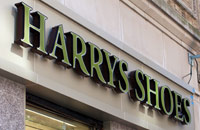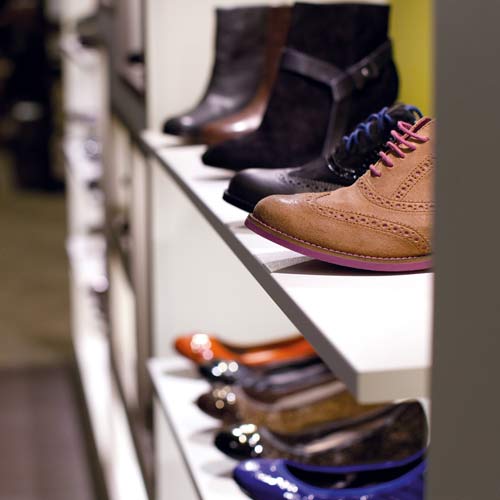
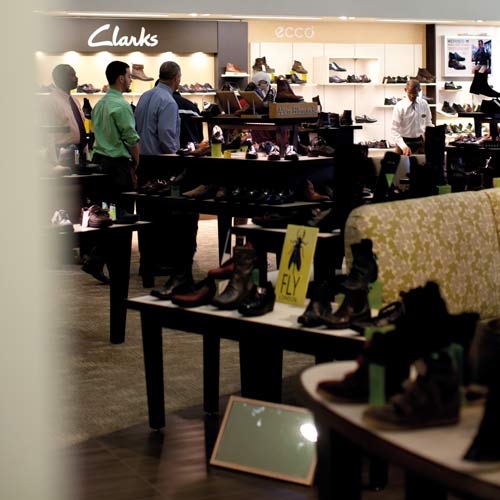
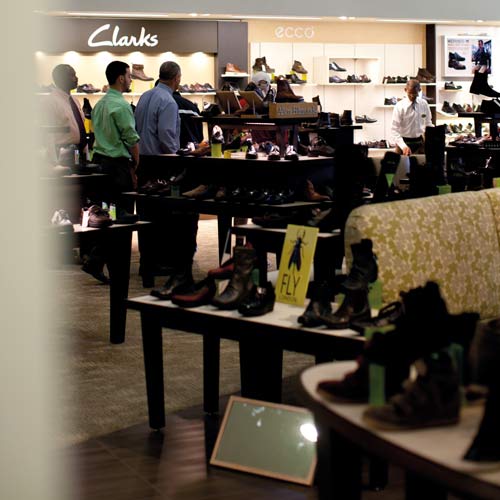

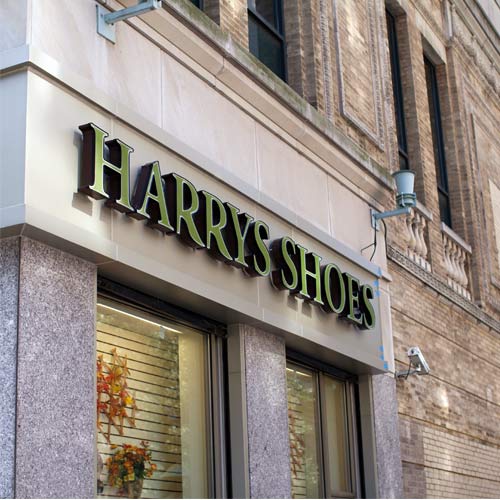
The recently expanded Harry’s Shoes on Manhattan’s Upper West Side meets the needs and wants of a neighborhood’s changing demographic.
By Greg Dutter
First, a little author’s disclosure: I have lived on Manhattan’s Upper West Side for the past 18 years. In fact, I live within 12 blocks—deemed but a short walk by most native, car-less New Yorkers—to the neighborhood stalwart, Harry’s Shoes, where my family has been frequent customers. Over the years, I have seen my share of yogurt shops, restaurants and Gap Outlets come and go within my beloved nabe. I have also seen my shopping desires and needs evolve as I moved through my early adult years (when bars, bike shops and gyms were top of mind) into my 30- and 40-something years, when the fatherhood era dawned and much of my shopping shifted to make-your-own pottery shops, grocery stores and drug chains for the neverending sundries a growing child consumes.
Apparently, I am not alone in my adult arc through life on the Upper West Side. The once seedier—as compared to the tony Upper East Side—and older-based demographic continues to undergo a suburban-like metamorphasis where strollers now outnumber taxis and parents desperately fight for the coveted, yet precious few, spaces in the area’s choice public and private schools. In short, these neighborhood pioneers are laying down roots and raising families here. The Upper West Side is considered by many realtors as the new “It” neighborhood, drawing in a mix of young professionals, many of whom rake in high incomes. Thus retailers must adapt to meet the wants and needs of its evolving customer base.
That’s one of the leading reasons behind Robert Goldberg’s decision to nearly double Harry’s Shoes (located on the corner of 83rd St. and Broadway) to 7,200 square feet of selling space. That and the fact that the neighboring Talbot’s closed and the realtor had come to him with an offer he couldn’t refuse. Sometimes running a retail business can be serendipitous like that. “We know that the demographics of the Upper West Side are changing dramatically and that there are other markets for us to be in,” says Goldberg, Harry’s president and the family’s third generation to run the business. “The neighborhood is getting younger, much more family oriented and it’s got a very high per-capita income rate. We knew that we had to evolve to meet this changing demographic where the DNA of our business will stay the same but the way we merchandise our expanded selection is more current and elegant.”
The fact is the old Harry’s couldn’t carry more brands even if it wanted to as it had maxed out its stockroom capacity. In addition, Goldberg says the selling floor had become so crowded that, in order to appeal to the fashionable brands he was seeking to add, more space and fixture upgrades were required to meet their standards. “It was a very good opportunity for us to build out and we were due for a remodel in the next two or three years anyway,” he says, noting the store’s last full remodeling occurred more than 20 years ago. But the decision goes beyond fortuitous timing; Goldberg knew the time was right for his store’s relevance. “We were starting to get pigeon-holed into being a store for more mature people. And we were finding it harder and harder to get the 30-something customer into our experience because we were looking dated,” he says.
Meet the New Harry’s
The expanded and remodeled Harry’s features a more sophisticated décor, including plush seating and enhanced shop-in-shop brand presentations, which includes (on the men’s side) the addition of To Boot New York, Santoni, Fratelli Rosetti, Hugo Boss and Converse by John Vavartos. “These are very choice brands,” Goldberg offers. “The idea was to appeal to a younger man, but not a sneakerhead.” He adds, “This is a little younger, cooler mix with a little more fashion spin, but we are also still a basic shoe store. We still sell a ton of Rockport.” On the women’s side, labels like Pas de Rouge, Bruno Magli, Attillio Giusti Leombruni and Peter Kaiser up the fashion ante alongside go-to store favorites like Dansko, Ugg, Munro and Merrell. When asked to define the new store overall, Goldberg says: “We are a lifestyle play for people who are looking for functional and also wearable fashion.” In other words: a sweet spot in today’s utilitarian-infused, casual fashion world. “It’s a great niche to be in right now,” he confirms. “It’s where the bulk of the business in our industry is being done today.”
It fits the tastes of many Upper West Side shoppers to a tee. Goldberg says it also fills a need, one he thinks is not found in the recently opened DSW outlet nearby and the since departed Plaza Too boutique that, he believes, went too couture. While many area residents can afford pricier shoes, they are not as inclined to drape themselves in the hottest designer logos. That’s more Upper East Side-y. Or, as Goldberg defines it: “A lot of Upper West Side women have Christian Louboutins in their wardrobe, but that’s not the flag they are rallying behind. Their flag is what works for their lifestyle, and they want it to be a little bit more relaxed.” He adds, “It could be Dansko or Merrell. Or it could be something as intriguing as Paul Mayer, Arcopedico or Arche. Or, right now, it could be Ash’s wedge sneakers.”
So far so good, Goldberg reports, regarding the reaction to Harry’s new digs and expanded selection. “It has been unbelievable. Customers walk into the store and say, ‘Wow. This is great,'” he says. He is particularly encouraged to see trendy, younger moms perusing the store’s expanded salon selection. “We wanted it to be distinctive enough so that it would look and feel like Harry’s, but also create a very positive impact on customers.” Mission accomplished.
Overall, what customers are seeing is something unique to the area, Goldberg adds. “There are not many independent shoes stores left around here,” he notes. “You have department stores, which do what they do, but it’s not like they take the place of us and their brand mix is different. And you have discounters, who are good at what they do, but consumers who are more discerning are not as likely to shop those stores.” In fact, Goldberg believes the new DSW is helping bring more shoe shoppers into the neighborhood as opposed to siphoning off sales. And while there is some brand overlap, he is focused on the bigger picture: “We have so many directions that we can go in our new environment that it will keep us away from them.” For starters, Harry’s is a full-service retailer—complete with Brannock devices. “We still measure every foot and fit shoes properly,” he notes. “And we still sell sizes and widths. Munroe American and SAS, for example, are very strong brands for us.”
Looking Ahead
If you think doubling the selling space means the goal is for Harry’s to double its overall sales, then you’d be wrong. Goldberg is not looking at the expansion that way. Such growth is not required, he says. “Our goal, in the next three or four years, is a 30- to 40-percent increase in our business.” It’s a realistic goal, he adds, taking into consideration the unique advantage that Manhattan offers as compared to much of the country that continues to struggle in a difficult economy. “There are markets within markets in this country,” he surmises. “And Manhattan, right now, is isolated from a lot of the other issues going on in the country.” Specifically, Goldberg says the borough continues to become more homogeneous of residents that have more disposable income. “The difference between $100 and $150 for a pair of shoes is not nearly as great,” he says. This increased license to spend is encouraging Goldberg to reach out to these coveted consumers. It includes holding more in-store events during the evenings, be it fashion shows and cocktail preview parties. Vendors are lining up to take part in that, he notes. Harry’s is also advertising more locally in Avenue and New York magazines as well as continuing with its New York Times campaign. Goldberg even made his “acting” debut via a commercial spot that aired on the local cable news channel, NY-1. “I learned just how hard it is to do that,” he laughs. “It looks easy when you see the final product, but the amount of takes took a long time.” Speaking of easy, Goldberg expects his day-to-day job to get a little more so, despite having to manage plenty more SKUs. “Ultimately, the expansion makes it a more comfortable place to work in because we’ll have more stockroom space and we’ll be able to manage the flow of our merchandise better,” he says. “And we have added some new staff hires to help out, but we are going to let that kind of organically evolve. I want to bring people on because there’s a reason for it as opposed to over-hiring and then having to cut staff. I’m trying to be more practical.”
Goldberg’s only regret in this entire process? The fact that his father, who opened Harry’s in this location in 1975, didn’t live to see its makeover complete. “He was very involved in the original planning and, when he was in the hospital, I would bring in the plans,” Goldberg says. “He was very proud that this was happening.” Goldberg’s grandfather started the business in two other Manhattan locations, beginning in 1931. “It’s a long legacy,” he adds. Speaking of which, Goldberg and his sister have two children apiece, so he hopes a fourth generation shoe retailer lies in the wings. “I think the odds of that are pretty good,” he says.
Goldberg Nuggets
Digging into the mind of a veteran retailer unearths wisdom on fashion trends, consumer behavior and retailing strategies. Why keep Harry’s Kids separate?
Kids need their own environment and a staff that caters to their specific needs. It’s like when they go for a haircut or to see the pediatrician: These are people that deal with children and understand their needs as well as the concerns of the parent.
What’s your outlook for the rest of this year?
A continuation of the transition from what we’ve all been seeing regarding how consumers shop. They are increasingly more buy now-wear now because of their overall outlook since 2008. Along those lines, what’s going to happen with Ugg? Nobody knows except that the weather will play a huge role. I’m optimistic and believe it’s still going to be a very strong business for us.
What’s your take on fashion in general right now?
From a retailer’s point of view, it’s a very good market because fashion is very eclectic right now. There isn’t one direction in clothing and people are being very individual in what they are choosing to wear, which means you can sell a lot of different categories of shoes.
Are we better off as an industry than we were four years ago?
I think we are because brands and retailers are being forced to become more innovative. Due to the Internet, the lifespan of a product is getting shorter and shorter. Trends get over-exposed quicker. And everyone has tremendous access to products now. Those who understand exactly who their customer is and what they want, have a tremendous opportunity to build a business with staying power. In contrast, it’s a very hard market to be an item chaser because you have a very short window span. If you are trying to meet a purely emotional fashion curve, which is what most stores try to do in order to gain maximum turn, you can do it but the window is narrower. And if you miss the beginning of that curve, don’t even try to chase it.
That’s not the Harry’s way?
My whole concept is I want to build equity in my customer. Meaning that we carry brands that they know and like and that serve their needs. They are brands that they can rely on and don’t have tremendous exposure everywhere. Of course, we also carry a few commercial brands that are commodities, because our customers buy those as well. Overall, I believe we offer a uniqueness that creates a reason to visit our store. It becomes part of the experience.
What was the best retailing lesson you learned from your father?
Always listen to your customer. It’s really that simple. The second rule is the customer is always right. Third: Just follow rules one and two. You can have your own insights into what think might happen, but at the end of the day the consumer is the ultimate critic and their choice whether to shop and buy from your store tells whether you did your job right.
Do you envision another location some day?
I’d have to ask my wife (laughs). For now, this is a big project and we are dedicated to making it as perfect as we can.

